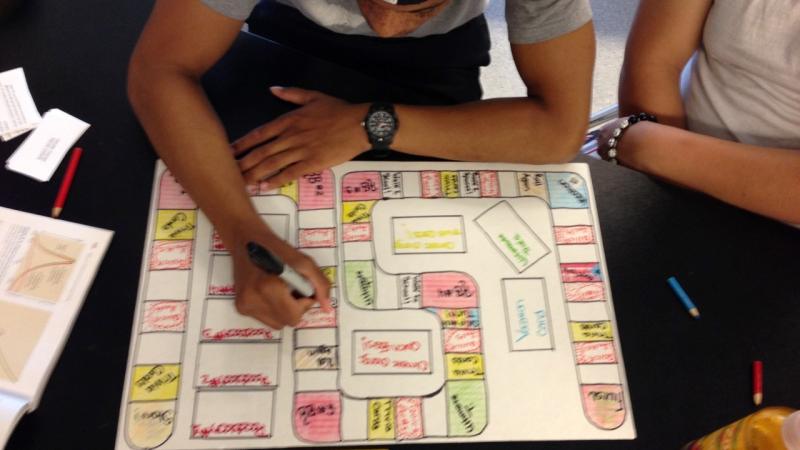July 30, 2015

Nature Geoscience today featured news of a climate board game and downloadable teaching module developed by Rensselaer Polytechnic Institute students and faculty in collaboration with Troy High School. The article – written by collaborators Megan Fung, a Rensselaer graduate student, Rensselaer Professor Mimi Katz, and Troy High School teacher Laura Tedesco – is part of a series on STEM education appearing today in Nature, Scientific American, and Nature Geoscience, publications of the Nature Publishing Group.
In the article, “Games and climate literacy,” which appears in the Correspondence section of Nature Geoscience, the authors discuss how they used game-based learning to engage students in science, and specifically in learning about “climate, how humans impact the environment, and the future implications of climate change.” The game and teaching module are among a suite of initiatives made possible through a five-year, $2.7 million National Science Foundation (NSF) GK-12 grant on “Building Bridges from High School to Grad School: Inspiring Students Through Discovery-Based Activities in Energy and the Environment,” which concluded in 2013.
Modeled after the “Game of Life,” players make life decisions that have an impact on their surrounding environment as they travel around the board. At each stage, players answer questions on cards in three categories (roadblocks, climate quick facts, and trivia), earning tokens for environmentally friendly answers. One “roadblock” card, for example, asks players to decide what type of car to buy. At the end of the game, the player with the most tokens wins the game. As part of the module, students play the game, critique it, and then design their own version which is in turn reviewed by their peers.
“I got interested in informal education as an undergraduate, and when the opportunity to work on the GK-12 program came up, I was very excited to see where this partnership between RPI and Troy High could go,” said Fung, whose research is overseen by Katz, one of the lead researchers on the NSF grant. “With climate literacy becoming a bigger subject in high school curriculum and my own research here at RPI focusing on paleoclimatology, I couldn’t think of a more perfect and important topic to focus on. I used to love playing the ‘Game of Life’ when I was younger, so I thought incorporating climate facts into the structure of the game would be a different yet interesting way to teach and learn about climate.”
Fung, Katz, and Tedesco report that the game was well-received in two Earth Science classes for at-risk students at Troy High School, with measured “improvements in class attendance, willingness to learn, and overall enthusiasm in the classroom.”
“A game is the perfect way for students to delve into the complex information that is available about climate change,” said Laura Tedesco, a National Board Certified Earth Science teacher at Troy High School. “What child doesn't want to take an exciting game and put their own touches on it, really make it their own? Students love to control their own learning, so they were highly motivated to design a game that would be challenging and fun to play with their peers.”
Katz, a Rensselaer associate professor of earth and environmental sciences, said the game has been well-received in several other venues, including a workshop at the Science Teachers Association of New York (STANYS) 2014 conference, a STANYS “Pub Science” teachers workshop, and a Rensselaer summer workshop for accelerated high school students and teachers.
Impressed with the efficacy of the climate change module and a similar activity on fossils, Katz said the collaborators have since developed the “Cascade Model of Learning for STEM Education,” a model for STEM education in which high school students learn by teaching others. Under the model, graduate students (in cooperation with science teachers and Rensselaer faculty) will design hands-on STEM modules for high school students, who can then modify the modules before they teach their peers or younger children. The goal is to stimulate interest in STEM among youth with diverse and disadvantaged backgrounds, while focusing on the environment and sustainability to provide societal relevance and increase community impact. The collaborators are currently searching for funding that would support use of the model in Boys and Girls Clubs afterschool and summer programs.